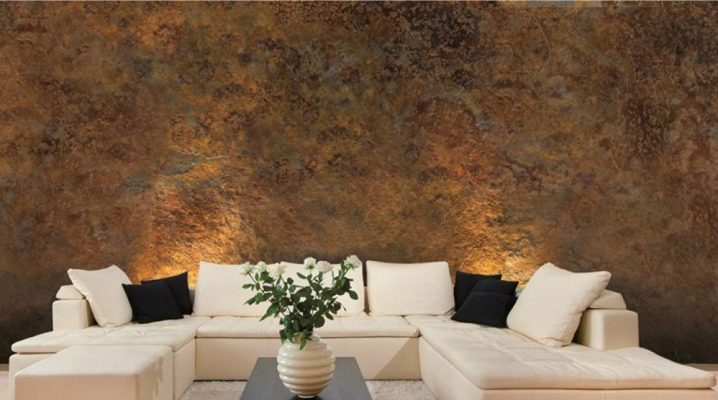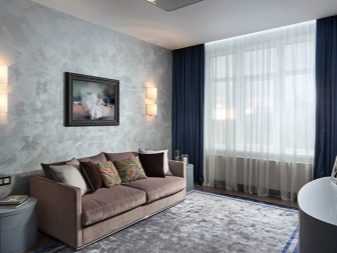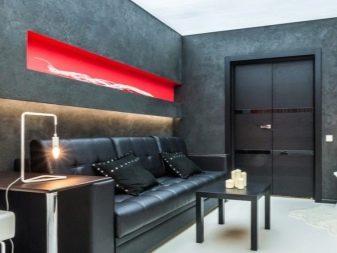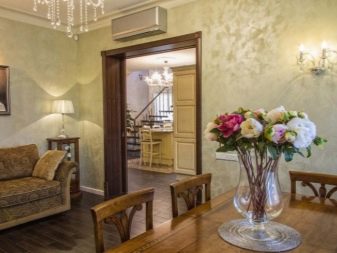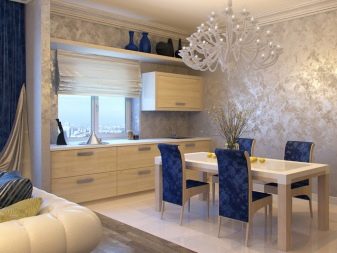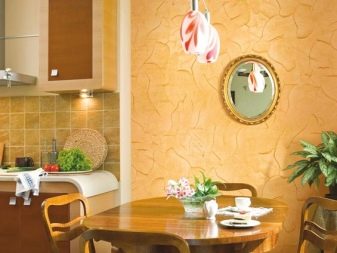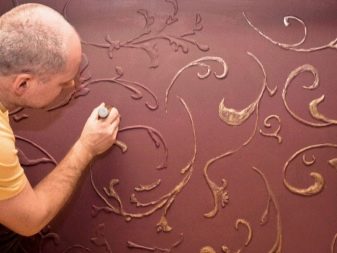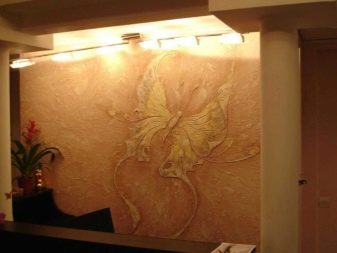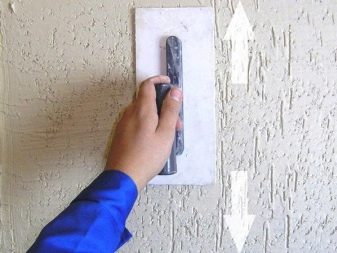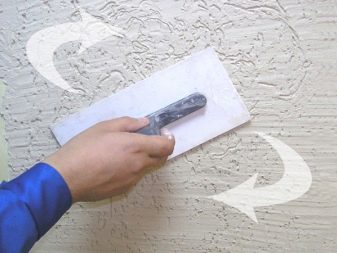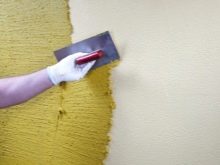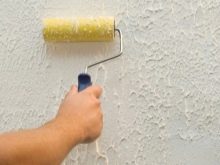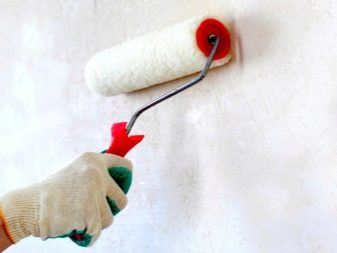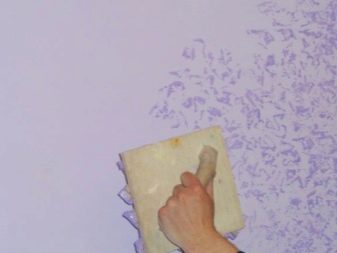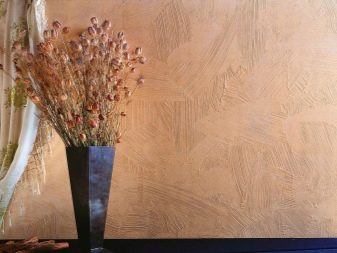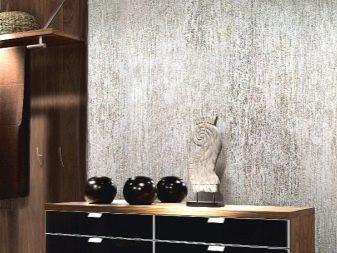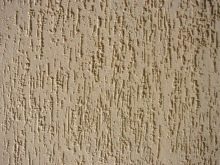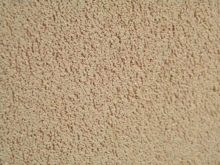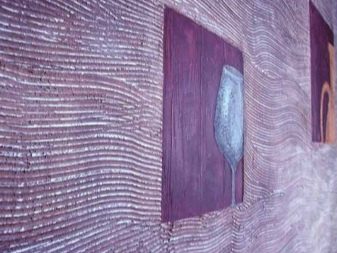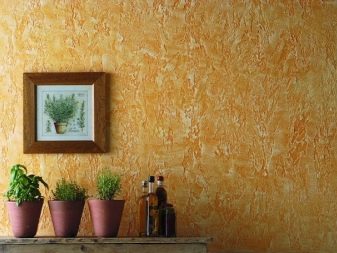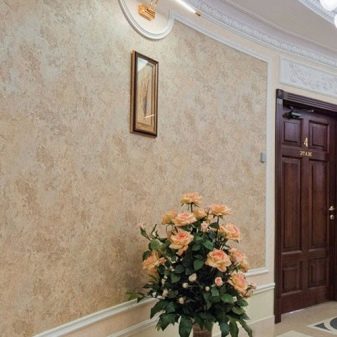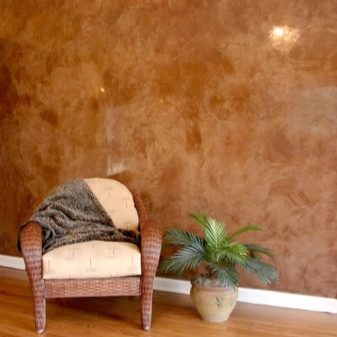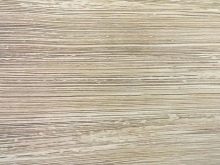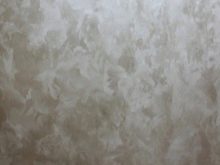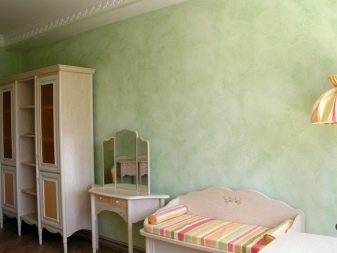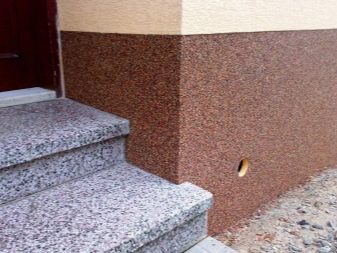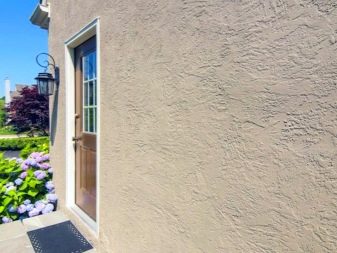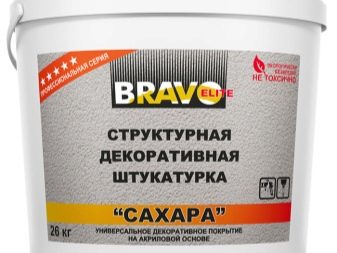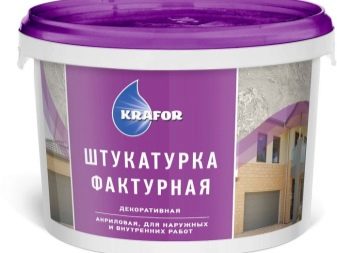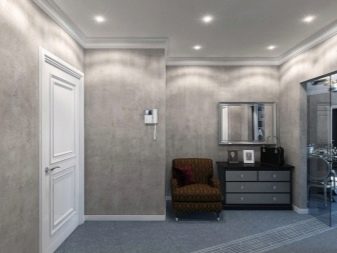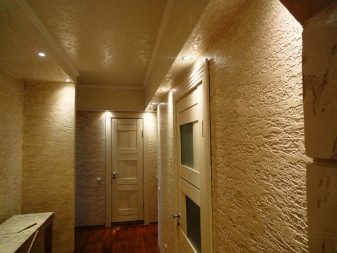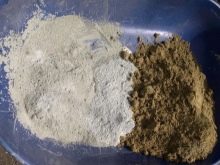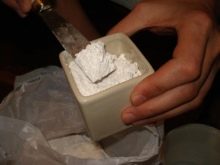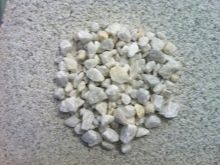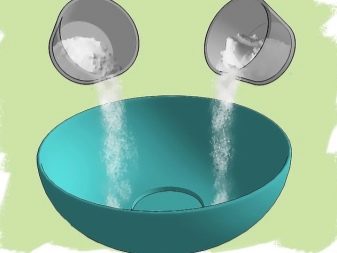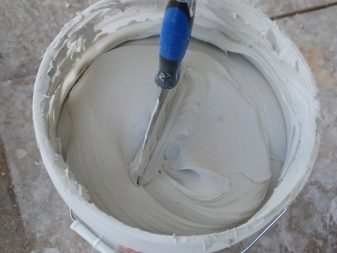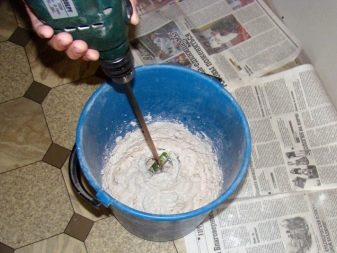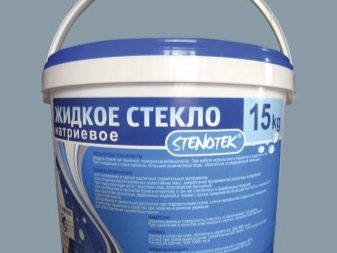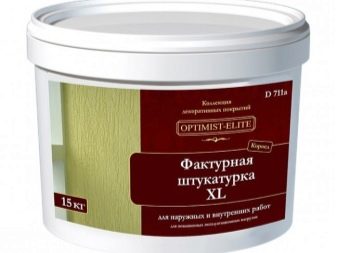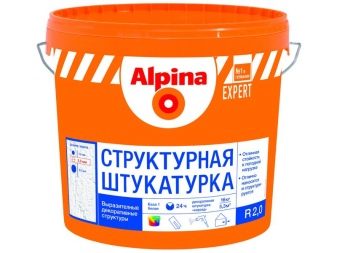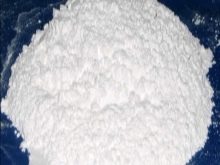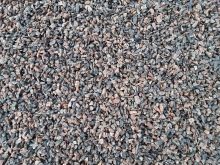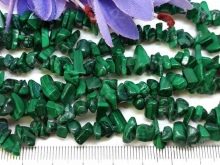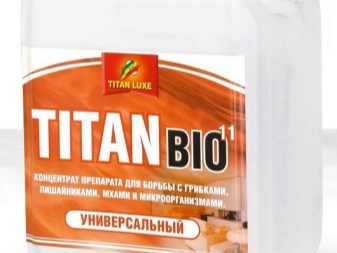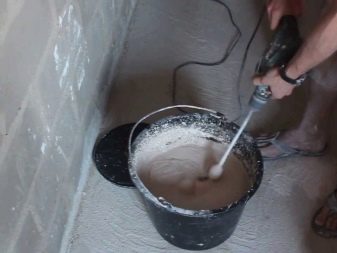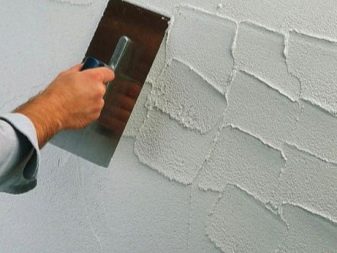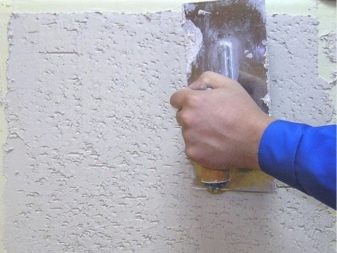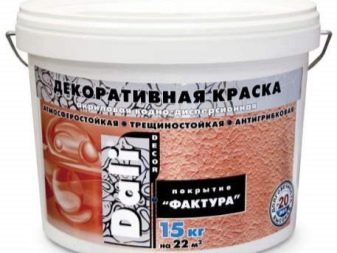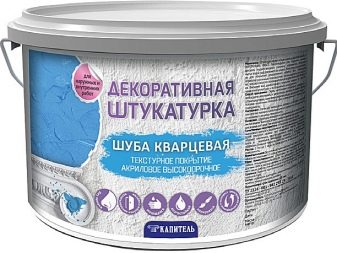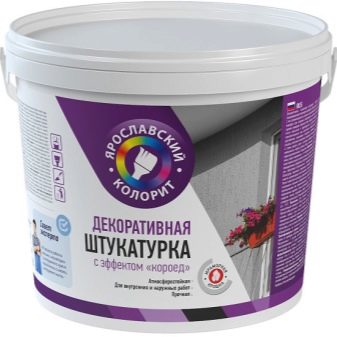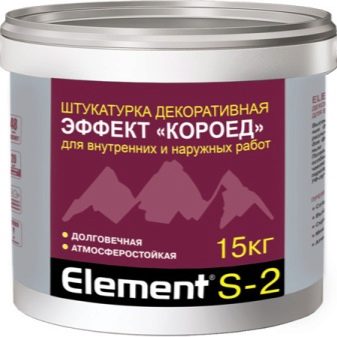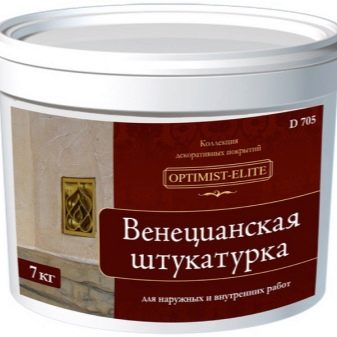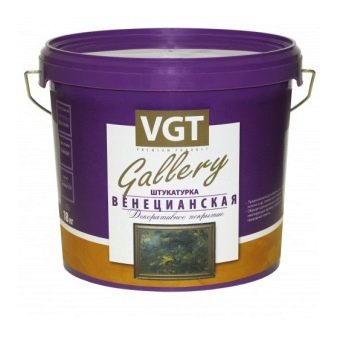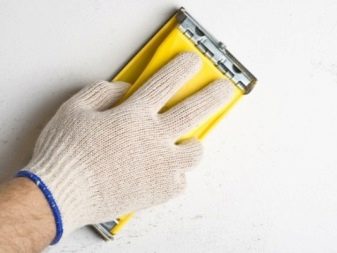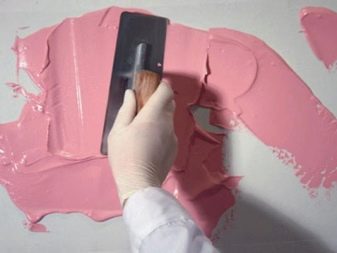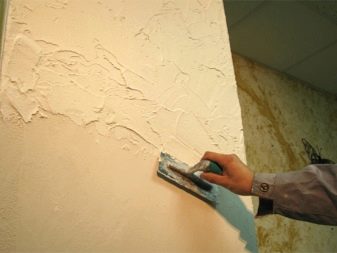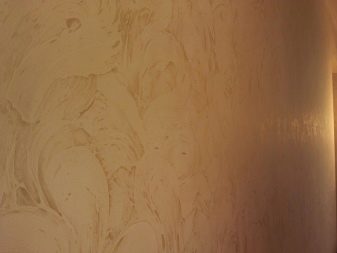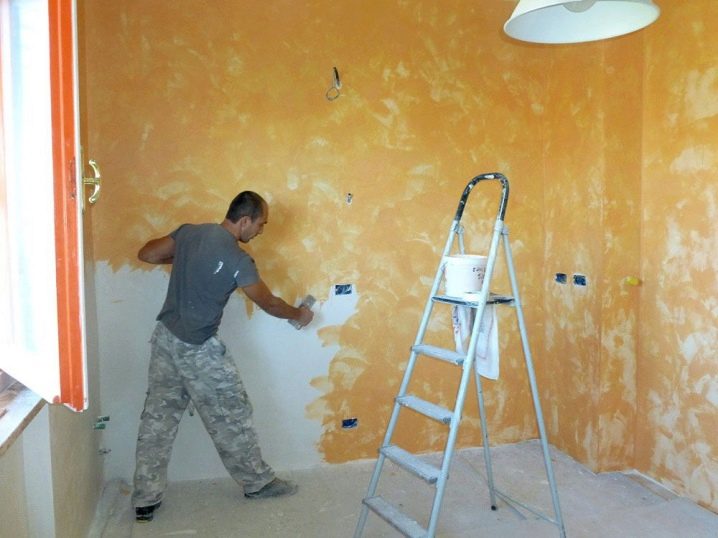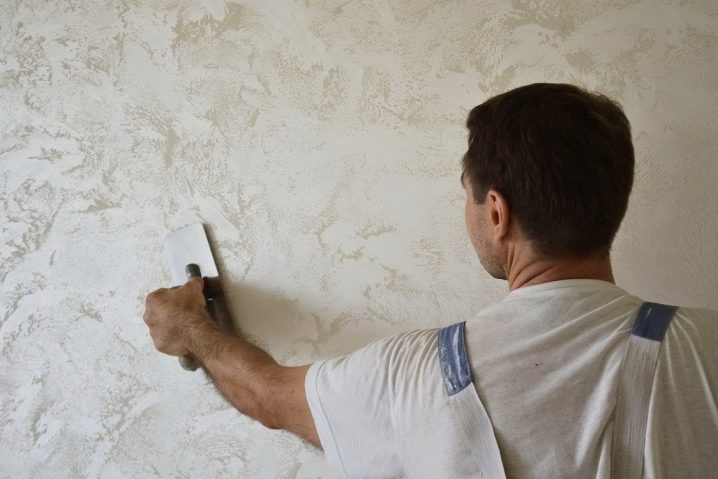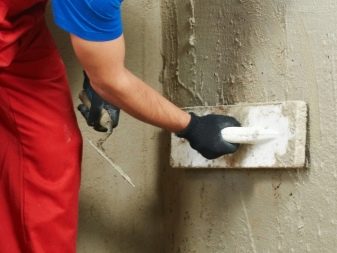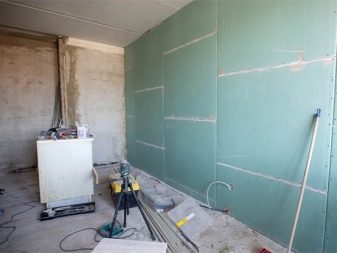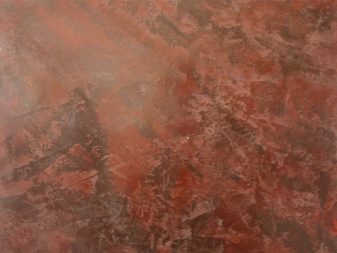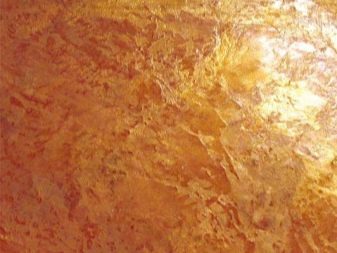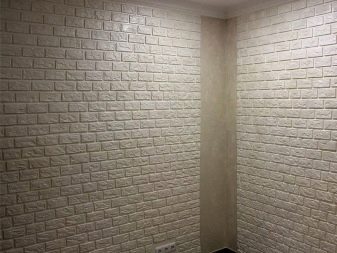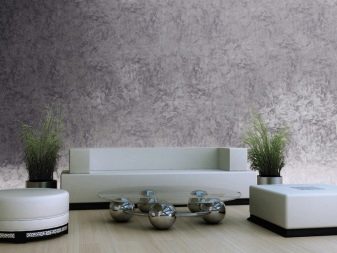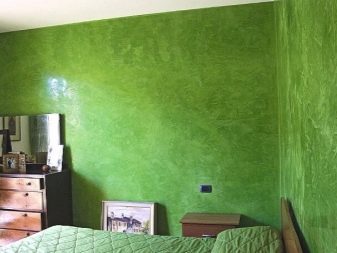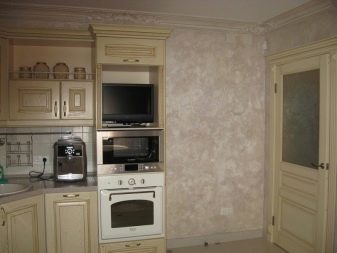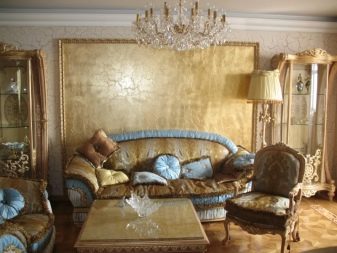Decorative plaster: preparation and application of their own hands
Currently, under the decorative plaster is commonly understood several different types of this finishing material. Experts claim that this is a marketing ploy of manufacturers. The composition of such a plaster is almost the same. It is necessary to study this aspect more closely in order to understand the types and methods of using this tool.
Special features
Decorative plaster is the main competitor of wallpaper in the issue of wall covering. It is worth knowing that this is not the material that is used to align the walls. This type of building material has its own characteristics. It is in itself and the equalizer, and the final floor.
The composition of decorative plaster includes additional substances that distinguish it from the usual.
It can be crushed stone from stone or wood fiber. Often, manufacturers began to add to the color base, so the coating does not need additional staining.
This type of finishing material has a number of undeniable advantages. For example, such a plaster can be the basis and at the same time the finish. It perfectly hides the irregularities of the wall and due to the high percentage of plasticity can fill any cracks and crevices.
Decorative plaster has no special restrictions on application. It goes well with stone, brick, concrete and plasterboard walls. The only feature is that it must firmly hold on the wall. But such a requirement applies to all types of finishing materials.
Decorative plaster does not absorb smells at all and perfectly will be suitable for registration of kitchen space. It is one of its features and indisputable advantage in comparison with other finishing materials. It has excellent sound insulation properties.
Another feature of decorative plaster is its unique appearance. The final version will look unique depending on the application technique and the tools used. If there are small defects on the wall, it is possible not to carry out preliminary preparation. Experts recommend doing only a small primer surface.
The most frequent use of decorative plaster is carried out indoors. It allows air and prevents the formation of fungi and other harmful microorganisms. Due to this specificity of finishing material, the repair will serve its owners much longer.
Due to the properties of the material in the process of finishing walls, you can create unusual patterns and designs. Some experts recommend making colorful drawings of decorative plaster. So the walls will look original and stylish.
Basically, natural components are a part of plaster. They are environmentally friendly and safe for people, children and pets. For some, this is the main criterion when choosing a finishing material. Such coverage can serve for many years.It withstands minor mechanical damage that can often happen in the kitchen and in the nursery.
When professionals work, everything seems simple and easy. When applying decorative plaster there are a number of features that need to be remembered.
This will help to avoid mistakes in the process of work and get the desired result.
When choosing decorative plaster you need to examine the entire range of this product, presented in the hardware store. Not be superfluous consultation of the seller. It is best to find a large sample with plaster applied on it. It is necessary to buy material with a stock. This will save on additional expenses and hassle. Not very nice if the plaster ends at the height of the repair work.
It is important to choose the right tools for a particular type of plaster. and achieve the desired effect. The minimum is the presence of two spatulas. It is necessary that one of them be wide and the second narrow. To make more textured drawings, it is necessary to purchase a special roller and ironer with round ends. If the owners want to paint the walls, then you need to purchase additional brushes or rollers for its application.
In the absence of serious defects, you can forget about the alignment of the walls.Decorative plaster has an amazing property - it will hide all the flaws. But if the defects on the walls are obvious, then you should first walk across the surface with a putty. This will greatly save the family budget. Experts believe that the smaller the embossed pattern, the better it is to align the walls.
Before using decorative plaster, the entire surface of the walls should be carefully primed. For a beginner master, it is better to start work from unobtrusive areas. This will help get a little experience, and the resulting defects will be hidden from view. Many builders recommend first practice on a drywall sheet.
After applying the plaster on it, you can make a certain relief or pattern. Qualitatively applied material is moisture resistant. Such walls can be washed. It is important not to use aggressive chemicals. It is better to use soft sponges and rags. Metal brushes and scrapers are not allowed when washing decorative plaster.
Some builders additionally cover this plaster with a layer of wax. But this method will protect from moisture rather than from various damage.In case of a need to change the interior, you can simply paint over the plaster with a different color.
In case of further pasting with wallpaper, it is permissible to putty the walls on top of the old layer.
Types and effects
In the construction industry there are several types of decorative plaster. Very often, it is divided according to the type of filler or binder. It is better to check with the builders or consultants in specialized stores about its quality and features.
If we consider this material as a filler, it will differ in appearance, and not in composition.
Consider some of the types and effects of decorative plaster:
- Textured or embossed plaster creates a rather noticeable pattern on the wall. It will help make any imperfections on the wall imperceptible. Such plaster is very inexpensive and is very popular in our country. It is quite simple to apply, which is an undeniable advantage for beginners.
It can be divided into several textures that have interesting names. "Bark beetle" resembles the grooves in the old tree. And when using color paint, this effect is only enhanced.The "lamb" creates a grainy surface that seems very soft and curly from a distance. "Fur coat" is a bit like the second option, but visually more fleecy.
- Structural view is the most unpredictable in the final finish. Even an experienced master will not be able to predict the final appearance of this decorative plaster.
- Venetian plaster has a smooth surface. To put it on the wall, the master must have sufficient experience. A lot of time is spent on its application. But in the end, the owners get the perfect wall, a bit like a stone. In bright light creates the effect of the marble surface and interior lighting.
- Other options decorative plaster have diverse characteristics. In the hardware store you can buy decorative plaster with the effect of wood. Popular is the material that imitates silk. Gypsum plaster is very popular to draw out household pantries and warehouses. Colored plaster can also belong to this group of materials.
Scope of application
This tool, many experts consider one of the most versatile types of finishing material. It is used on any surface. The result is a very interesting and intricate relief of the walls and ceiling.
The widespread use of plaster due to good vapor permeability, durability and resistance to various natural influences.
In addition, this type of material does not always imply additional plastering of the walls.
When using this material in the nursery, you should carefully choose the composition. Decorative plaster should not contain resin of synthetic origin. When applying the material on the walls do not make sharp corners. It is important to think about the safety of your child.
In the bathroom and the toilet is to use material based on cement.
For the kitchen area is to use glass and plastic aprons. This is especially true of the cooking area and washing dishes. For those who want to use decorative plaster in the kitchen, experts recommend to cover the walls with an additional layer of paint or clear varnish. Such additional protection will help protect the walls from grease and soot,which are simply inevitable in the kitchen.
On sale there is a special type of material which is intended for external works. This type of plaster is absolutely not suitable for use at home. It is associated with the constituent substances. They give plaster additional resistance and durability to the effects of snow, rain and sun.
Other blend options are for indoor use only. Such decorative plaster is environmentally safe and contains natural ingredients. This material can not be used for finishing facades of buildings. Due to the natural composition and the absence of aggressive components, the material will not withstand the effects of natural disasters.
In specialized stores you can find and universal plaster. It is permissible to use in residential apartments. It showed itself well when used on the facades of buildings. As a part of such decorative plaster there are safe substances for people. In the composition there are special components that extend the life of the material on the facades. This type of decorative plaster is the most expensive.
Many builders believe that such plaster looks great in rooms with a large area. With the help of decorative plaster trim all walls or its small fragments. Designers are confident that some types of material can visually increase the area of the room.
This is achieved by a special style of application and the use of light paint.
Currently, the material can be applied to wood, drywall or brick. As a basis, you can use a concrete or already plastered wall. Plastic surface is not the best option for applying decorative plaster. It is a fairly strong material, so it is important that it be properly applied.
It is allowed to use in the hallway. She will be able to endure minor mechanical damage that may occur in everyday life.
How to cook by yourself?
Currently, this type of finishing material does not lose its popularity. Construction stores represent a huge range of this material. It has a different composition, service life and finishing surface.Combines all types of decorative plaster only quite high cost.
If you want to have an original interior, but limited financial resources or a well-defined estimate for repairs, you can try to make a decorative plaster with your own hands.
Sand, gypsum or cement may be included. Fillers can be a crumb of natural stones. It is desirable to add components to the resulting composition to increase the viscosity of the material, as well as antiseptic and moisture-resistant additives.
Finishing option will depend on the type, quality and quantity of filler. In the most widely used version of decorative plaster there are grains up to five millimeters in size. It is important to know that in decorative plaster the filler should not exceed 70% of the total amount of the solution.
There are different ways of making decorative plaster. Consider the most simple and popular ones.
Very often plaster plaster is used during repairs. This type of decorative plaster dries instantly, is easy to apply and is well leveled. Making it very simple.You need to buy flour from gypsum and make the dough out of limestone. These components must be mixed together in a ratio of one to three. Then a small amount of water is added. It is necessary to pour in water gradually, stirring the solution evenly.
As a result, it should resemble thick sour cream in its consistency. At the very end, if desired, the color is added. To make the solution plastic, all proportions must be strictly observed.
To make lime dough yourself, you will need hydrated lime and water.
The ratio of components should be one to three. After kneading, the resulting texture is covered with a lid and cleaned in a dark place for about a day.
Popular methods of making plaster at home and with the addition of components based on silicate. Preparation of the bulk is carried out in the same way as in the first case. Another element is liquid glass. It is poured into the resulting solution, and then add a little water. The amount of silicate in this mixture should not exceed 5%.
A budget option for decorative plaster will be a mixture of sand and cement.To prepare such a composition, you need cement, sand and lime slaked. The proportions of such a composition are approximately one to two. After mixing the main components, silicate is added to the mass. Its share should not exceed 5% of the total mass. At the very end, water is added to the mixture. Stone stone should not exceed 70%.
These are fairly simple material manufacturing methods. It is important to respect the accuracy of proportions and consistency. Before starting work, you can see a master class of an experienced builder.
For the purchase of decorative plaster, which does not require preliminary preparation, it is necessary to turn to ready-made mixtures. In this case, you should pay attention to textured plaster. Its surface is almost flat. The desired pattern is obtained with spatulas, brushes and rollers. In addition, an experienced master has more opportunities when working with such material. Structural plaster is applied much easier and faster. It is ideal for an inexperienced master.
For rooms with high humidity you should pay attention to cement plaster. Builders add about ten kilograms of tile glue to the bag of cement.In the resulting mixture is added 500 grams of plasticizer. Then water is evenly poured in and everything is thoroughly mixed.
Venetian plaster is considered the most exquisite and amazing. It refers to textured varieties. Due to its popularity and variety of effects, it is distinguished into a special group.
Dust from marble is quite expensive. To reduce the cost of manufacturing such a coating, granite and malachite chips are usually added to it. After applying the material on the wall requires treatment with a trowel. This means that the plaster must have a very fine grinding of stones in its composition.
For this, it is better to use natural and fine fillers.
The next component is hydrated lime. It acts as a component for a bundle of all means. Typically, in the finished construction mixtures instead of hydrated lime, the composition contains resins from acrylic. Special dyes will also be required. Previously used natural sap plants. Currently, synthetic components have replaced them.
In work use of flowing water is possible. It is important to monitor its temperature. It should not be below ten degrees. In the standard recipe of Venetian plaster, all of the above components are present. Stone dust and slaked lime are thoroughly mixed until they form a homogeneous mass of a rather thick consistency.
Then running water is added to the resulting composition and again everything is mixed. At the same time dye, antiseptic and metallizing particles are added. Due to the characteristics of the application of this type of decorative plaster required the smallest fraction of the fillers.
Experienced builders offer to consider two more options for the preparation of this type of material. The first is quite simple - the material is mixed with white marble flour. The proportions are one to ten. Then in the resulting composition is added water and color paint.
The second option in the preparation of a little more complicated. At 7 kilograms of sand from marble, about 1.5 kilograms of flour of similar composition is added. Then white portland cement in the amount of 700 grams is added to the composition, then about a kilogram of dough from lime.
A beginner master needs strict adherence to all proportions. It is better to use paper to record all the components.
Consumption per 1 m2
Before you begin finishing work using decorative plaster, it is important to make a competent calculation of the material. As a rule, it is considered to be a mixture consumption per square meter.
Decorative plaster perfectly imitates stones, wood or leather. Despite its cost, it is very low cost. The most common consumption per square meter of a wall or ceiling is from one kilogram to one and a half.
Plaster, resembling the texture of the tree, has the smallest expense. The total thickness of the layer should not be more than one centimeter.
If the composition of the plaster has a large grain, then you need to apply two layers.
Structural plaster is made from a mixture of acrylic, cement or plaster. This mixture is sold in packs of 25 kilograms. To decorate a wall of ten square meters you need one or two bags.
The mixture based on acrylic dispersions is uniform in consistency with the presence of small grains in it. The size of these grains does not exceed two millimeters.The plaster in finished form has a rather tangible expense. In the presence of a fraction of one millimeter consumption is two and a half kilograms per square meter of the wall or ceiling.
Such plaster is usually sold in plastic packaging of 15 kilograms. For 10 meters of the wall you need about two plastic packaging. This amount of material will be needed for applying one layer of decorative plaster.
Structural material, which includes marble chips or a mixture of marble and granite chips, is in great demand. The layer of material can be from one to three millimeters. It depends on the required depth of the texture. To put the material on a wall of 10 square meters, you will need one package of material with a volume of 25 kilograms.
If we consider the structural material, then most often it is used when finishing the fireplace. A solution of such plaster is sold in plastic packaging of 15 kilograms. To put plaster on a wall of ten square meters, you need to buy two packages of material.
We should also mention the decorative bark of bark. Consumption of this tool ranges from 2.5 to 4 kilograms per square meter. This variation is due to the different grain sizes in the structure of the product and the layer thickness.
Yet before buying it is worth consulting with the seller in the hardware store. The specialist will accurately determine the possible consumption of decorative plaster of this type. It will not be superfluous to get acquainted with the information about the material on the package.
Venetian plaster allows you to create on the wall an imitation of marble in all its glory. In terms of consumption, it is the most budget. Savings are due to the perfectly aligned surface. Given the cost of the work and the price of the material itself, Venetian plaster is the most expensive.
Application process
Plastering work will require a set of tools. This should be sandpaper or a special machine, two types of spatulas, brushes, polyethylene film, putty and primer.
The technology of applying decorative plaster is not very complicated.
At the beginning of work, the surface is cleaned and the traces of corrosion, old paint or wallpaper are removed. The entire surface is treated with sandpaper. The remains of dust can be cleaned with a vacuum cleaner or brush. Cracks or gouges may appear on the wall. They should be puttyed up and wait until it is completely dry.
After that, it is worth treating the surface with a primer. It should be applied twice with an interval of 3-4 hours. This stage of work is required. The primer will improve the adhesion of the plaster to the wall.
In the process of drying the primer material, the entire working area should be covered with a film of polyethylene. It is advisable to cover the furniture and all mirror surfaces. For reliability, the film is fixed with construction tape. Then you should proceed to the preparation of decorative plaster.
For the application of structural material using a spatula with a wide base. The plaster is applied to the wall and then stretched with a wide trowel. The first layer can be of different thickness, as long as it is even. You can continue to work only after 5-12 hours. During this time, the plaster must be thoroughly bonded with the wall and primer.
After that, the entire surface of the wall is treated with a plastic trowel. You can move in a circle or randomly. Due to the solid granules in the composition of decorative plaster furrows are formed on the surface. After the material dries, they will create the effect of natural and natural materials.
After that, you need to leave the walls to dry for at least another day. Then a special primer is applied and rollers and brushes are used. With their help, the specialist applies the first coat of paint, and then the second. The last coat of paint should be a shade or two lighter than the first. The final stage of the work will be applying a layer of wax.
When working independently, it is best to place decorative plaster with a wide trowel. It dries for a long time, so you can apply it to all walls at once. In order for a pattern to form on the surface, the thickness of the entire plaster must be three millimeters. In this case, it is important to walk through all the walls or the ceiling.
Without letting the material harden, you can proceed to the next stage of work. Here will be useful brushes, stencils, stamps, rollers and trowel. Thanks to uneven drawings, plaster will acquire a certain texture. The resulting solution can not be forced through deeper than one and a half millimeters.
If you do this, the material will not be strong and will very quickly begin to peel off.
A day after the end of the work, the entire surface should be primed. Then the walls are waxed.It will be possible to touch and place the furniture in this room two days after the completion of all construction works.
Venetian plaster more capricious and difficult to work. In the case of self-preparation of the solution is to use a spatula with a wide base. The surface is leveled with a trowel.
Strongly press on the tool is not worth it. All movements must be chaotic. You should also apply the second and third layer of Venetian plaster. The interval between the application of layers is from eight to ten hours.
Then the trowel for Venetian plaster is strongly pressed to the surface and passes through the entire wall. This should be done until you get a metallic sheen. At the very end, the wall should be waxed and gently sanded.
It is quite possible to prepare decorative plaster by yourself. It will take a little more time and effort, but quite significantly save the family budget.
Tips
You should always buy decorative plaster with a margin of at least 10%. It will be needed if the material dries or falls to the floor during application.
The issue of saving is always very relevant. This is especially true cost estimates for repair work. Experienced craftsmen have some rules and secrets that can reduce the consumption of material per square meter.
For rough work, they suggest using the most cost-effective cement-based mixtures. At the beginning of the work you need to try to align the walls to the maximum. Swings should not exceed five millimeters. In the case of too curved walls it is worth using plasterboard. This budget option will help to quickly and more economically give the walls a smooth surface.
You can not save on primer material. It is best to use those tools that are recommended by the manufacturer of decorative plaster. Most importantly, before starting the repair everything is properly planned. Correctly calculated quantity and selection of successful consumables will help save and save you from additional purchases.
Skilled craftsmen recommend practicing in puttying walls to be able to apply decorative plaster in various ways.
When using Venetian plaster worth watching video tutorials or sign up for special courses. Do not forget about the rough samples.They are best done a few days before the start of the main work. For this perfect drywall. Decorative plaster is a very expensive material, so you should carefully prepare for its application.
The beginning master should put decorative plaster on small sites of walls. These can be arches or small drywall structures. On them minor defects will not be so noticeable. But a large canvas wall will not give the opportunity to hide the first experience of a novice master.
An interesting design option for the corridor and part of the living room will be brick or masonry. It will look more elegant if you make an imitation of brickwork with decorative plaster. Imitation saves space. Time for construction work will take much less than when using this brick.
It is possible to create imitation brickwork in two ways. In the first case, the wall is drawn by hand, and in the second, special metal stencils are used. Decorative plaster is poured into them.
When working independently, a novice master should use a narrow metal spatula.This tool will help smooth out the edges of the "bricks" and add a little texture.
What method and type of decorative plaster would not be chosen, it is important to treat the matter with the utmost care, to learn in advance all the features of the application and preparation of decorative plaster. Then a great result will not be long in coming.
See the next video for a master class on applying velvet relief plaster.
